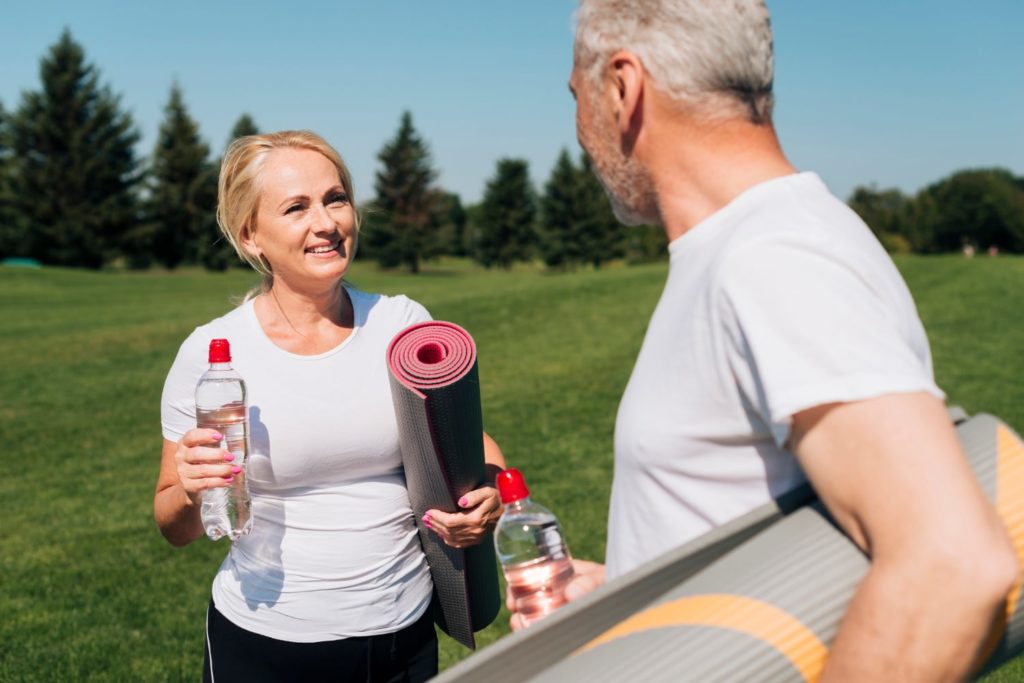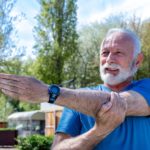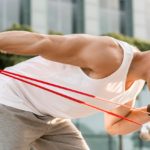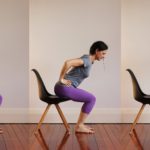
Kim Hoffmann
NASM CES (Corrective Exercise Specialist) and Certified Personal Trainer

Craig Ballard
(MSc (Sports & Exercise Nutrition), BSc, BTEC (Sports & Exercise Sciences), CYQ/QCF (Personal training and Instruction))

Megan Rodden
(BCS, DipNat, MedHerb, NMHNZ)
Getting back to exercise seems to be harder with each passing year. However, don’t get discouraged by thinking that you are too old because today, 40s and 50s are like 20s and 30s when we look at the time when our parents and grandparents were young.
This means that today, with proper nutrition, sleep and natural supplementation, we can enhance our exercise results and extend our youthfulness and longevity.
But the first step to success is setting a goal that’s achievable and within a reasonable timeframe.
Goal setting
Many people will advise us to make SMART goals:
- Specific
- Measurable
- Achievable
- Realistic/Relevant
- Time
The more specific and detailed we can make a goal, the more likely we are to stick to our routine in order to make it happen. In short, SMART goals require us to break down our goal from:
- “I want to lose weight” to “I want to lose 5kgs of body fat in 3 months”.
- “I want to get stronger” can become “I want to improve my deadlift by 5 kgs in 4 weeks”.
When goals are too big, most people lose track of the process. In general, we need direction and guidance when it comes to exercise, whether it’s help from a personal trainer or keeping track of our workouts.
Find your ‘why’
Some people will advise us to find our ‘why’ to make a goal. For example, “I want to be fitter so I can run around with my kids”.
For some people that may be enough motivation. For others it might not.
Find a motivation that works for you
For example, if you want to be able to run around with your kids, do it because it makes your life easier.
Obstacles
Sometimes life will throw us curveballs. For example, we got a promotion at work but that means extra responsibilities and time.
These things happen and they’re unavoidable. It’s okay to pause or adjust your routine. There is only so much we can do in a day and if we can’t get everything done, it’s okay to not exercise as often or as regularly as we had planned.
Align environment with goals
To make it easier to incorporate exercise into our daily life, we should have our gym gear ready, regardless of when we want to exercise.
If you prefer working out at home, you can set up part of the garage or put dumbbells next to your bed.
Inform your partner or kids of your goals. They can help with accountability, motivation or giving you help. They may give you that push you need to go to the gym that afternoon.
Time frame
How long a goal should take to reach will be different for everyone. Maybe you have an overseas holiday planned and you know there will be lots of walking involved. Or you’d like to get more active or mobile to play with your grandchildren.
These are very different goals and require different time frames.
The important thing when planning your goal is to make micro-goals.
Consistency
One of the most important things we can do when it comes to exercise is to be consistent.
Too many people drop off because they haven’t reached their goals quickly enough. Re-evaluate, reset your goals and trust the process.
Keeping track
When we set a goal, ideally we want to keep track of where we are currently at, so we don’t need to guess where to start from every time we exercise.
For example, you could keep track of the weights and repetitions you are doing at the gym, or the distance or the number of steps you are walking each day.
Most people will feel good about themselves when they see that they’ve been increasing the weights on their lifts, the distance they’ve walked, or their daily step count.
Tracking also holds you accountable. If you don’t feel like going to the gym, knowing the progress you’ve made will remind you of why you should go.
Also track what you eat. If you’re not making progress, maybe your nutrition needs some tweaking, not the workouts.
Exercises — weight training
The best exercises we can do for weight loss and strength training are full body exercises, or compound exercises. These exercises use more than one muscle group to move – think of a squat compared with a leg curl.
My favourite exercises to use with my clients are:
- deadlift (any variation)
- squat (single leg and double)
- bench press (any variation)
- standing overhead press with barbell or dumbbells
- bent over barbell row
The reason why these are good exercises is because they use most of the body to move the load. That means that we can create muscle growth in pretty much every part of the body by doing one exercise.
Overall muscle growth is what we need for any goal, whether it is strength training or a more toned physique.
Exercises — cardio
All cardio is good cardio. However, it depends on what we want to get out of it. If we want to improve our heart health, both slow and steady walks or high intensity cardio will help. If we want to lose fat, slow and steady is the way to go, but it’s more time-consuming.
Low-to-medium intensity cardio is best for weight loss
RELATED — Zone Training: What is it and what is it good for?
Whatever cardio you end up doing, make sure you enjoy it. There is no point in running if you hate it.
The amount of time you do cardio will depend on how much time you have. If you need to choose between a strength training session and a cardio session, have a look at how often you’ve done either and what you prefer.
Nutrition
If you are starting to exercise again because you want to lose weight, then this means you will have two key (and interrelated) goals, which is to reduce body fat and to improve overall body composition.
This involves managing the energy we consume and expend, with calorie tracking currently being the most accurate method available.
Creating a calorie deficit, where we consume fewer calories than we burn, is fundamental for fat loss. Any diet that promotes fat loss works under this premise.
Aim for a sustainable calorie deficit of 0.5–1.0% body weight loss per week, typically achieved by reducing daily calorie intake by 300–500 calories.[1]
Improving overall body composition involves more than just losing fat; it’s also about gaining or preserving muscle mass and aiding recovery.
A diet rich in protein is beneficial for achieving these goals, with recommendations ranging from 1.4 to 2.0 grams of protein per kilogram of body weight per day for most active individuals.[2,3]
However, during periods of calorie restriction, a higher protein intake (around 2.2–3.0 grams per kilogram of body weight per day) is advisable, with 20–40 grams of protein per meal.[2,3]
Fats are crucial for hormonal health
This is especially true during dieting, with a minimum intake of more or equal to 0.5 grams per kilogram of body weight per day suggested.[2]
RELATED — Introduction to: The Ketogenic Diet (Part 1)
Carbohydrates are essential for exercise performance, helping preserve lean body mass and promote exercise intensity. Intake depends on individual exercise requirements but often falls between 2 and 5 grams per kilogram of body weight per day.[2]
Fibre aids in appetite suppression and gut health, with a rough guideline of 30–40 grams per day recommended.[4]
Hydration is often overlooked but is crucial for:
- supporting metabolic processes
- aiding digestion
- regulating body temperature, and
- suppressing appetite
Our water needs vary depending on the individual, climate and physical activity level, but aiming for 3–4 litres per day is a good starting point. You can check if your intake is sufficient by monitoring your urine – ideally it should be pale and odourless.[5,6]
Other factors like meal timing and frequency, micronutrient intake, and supplementation can also affect fat loss, but their impact is minor compared with calorie intake and protein consumption.[1,7]
No matter what diet approach you decide to follow, there is no single best strategy for weight management if calorie and protein intakes fall between suggested guidelines.[8,9]
The most effective diet is the one you can maintain, whether it’s intermittent fasting, low-carb, ketogenic or low-fat.[7,10] Some approaches, however, may be less practical for achieving optimal carbohydrate and protein intake for exercise performance and recovery.[11]
To summarise, general nutritional guidelines for fat loss and exercise recovery include aiming for:
- weight loss rate of 0.5–1.0% body weight per week
- consuming 2.2–3.0 grams of protein per kilogram of body weight per day
- eating 3–6 meals daily, and
- including a high-protein meal 2–3 hours before and after training, and monitoring calorie intake and body weight changes to ensure effective fat-loss progress.[1,2]
Main takeaway: maintain a weekly calorie deficit with a sustainable, high-quality diet that preserves lean mass.
Natural supplements
As mentioned, getting back into exercise after a long period of inactivity can be challenging; however, there are a number of natural supplements, such as herbs and nutrients, that may provide support for the mind and body.
RELATED — Nutrients
Depending on your specific goals and individual health needs, the following herbal and nutritional supplements may be beneficial.
Adaptogenic Herbs
Adaptogenic herbs help the body to adapt and cope with stress and have been studied for their capacity to improve muscle recovery, stamina and endurance.[12]
Ashwagandha (Withania somnifera)
Ashwagandha is an Ayurvedic adaptogenic herb that may support exercise performance and recovery. A 2021 analysis of 12 clinical studies concluded that Ashwagandha was more effective than a placebo for improving strength, fitness and recovery in healthy men and women.[13]
One of these studies showed exercise adaptations to resistance training increased after 12 weeks of supplementation with 500 mg of Ashwagandha.[14]

RELATED — Ashwagandha (Withania somnifera)
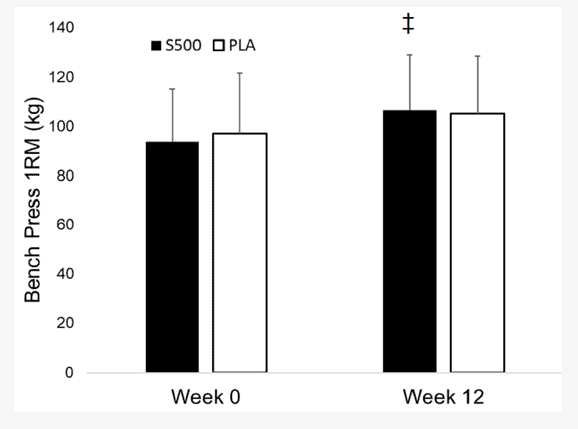
Ginseng (Panax ginseng)
Ginseng is an adaptogenic herb which has been used for centuries in traditional Chinese Medicine as a tonic to increase vitality and reduce fatigue and may help support a return to exercise through improved muscle recruitment and recovery.
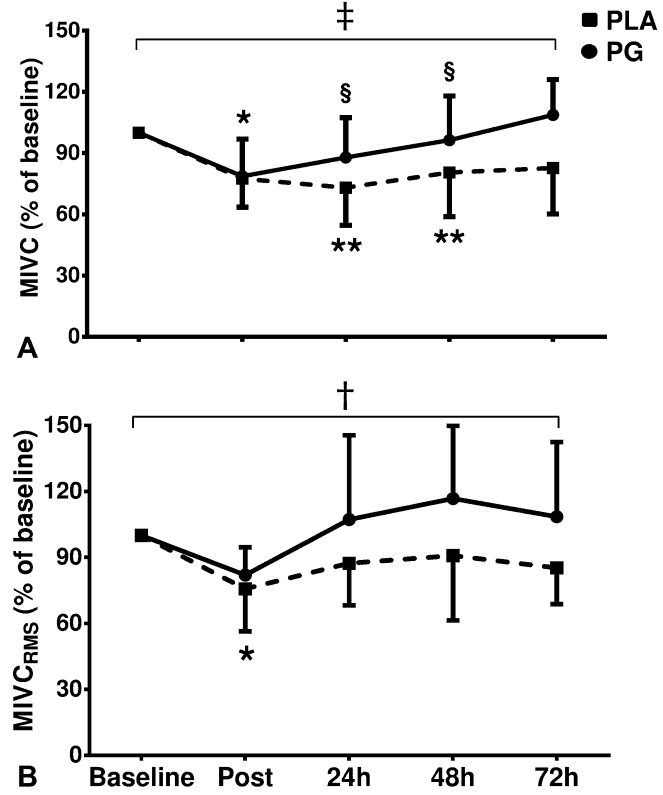
The above study showed that supplementation with Ginseng, in athletes, increased muscle recruitment and excitation, and reduced perceived effort and improved recovery.[15]
If you would like to read more about similar studies, we suggest visiting our section on Herbs.
Nutrient supplementation
Chromium
Chromium is an essential nutrient which may help maintain lean muscle while shedding fat when taken in the bioavailable form chromium picolinate.
Chromium is found in many foods like eggs and shellfish but the levels in our bodies are often suboptimal because absorption is reduced by diets high in simple sugar.
RELATED — Everything You Need to Know When Buying Eggs (Part 1)
One clinical study found that supplementing with chromium picolinate significantly improved body composition with 98% fat loss and only 2% lean body mass loss, with a greater reduction in body fat percentage after 90 days compared with the placebo.[16]
Magnesium
This essential mineral is involved in over 300 biochemical reactions in the body, including energy production and muscle function. Supplementing with magnesium when returning to exercise can support muscle relaxation, reduce cramping, and improve sleep for recovery.
RELATED — Magnesium (for a great night of sleep)
Relaxation
Mindfulness Meditation
Regular meditation practice can help reduce stress levels, improve mood and enhance focus. By cultivating mindfulness, we can better tune into our body’s signals of hunger and fullness, making it easier to maintain healthy habits during weight loss.
Studies have shown mindfulness meditation can enhance weight-loss programmes and effectively improve eating behaviours in overweight and obese individuals.
RELATED — Introduction to Mindfulness: Enjoy the present moment and appreciate life
Visualisation
Visualising successful workouts and achieving weight-loss goals can boost motivation and confidence, making it easier to stick to your new routine.
Visualisation techniques can also help us overcome mental barriers and push through challenging workouts.
Related Questions
1. Should I hire a personal trainer when starting to exercise again?
If you can afford to, yes I would suggest you do. This is the easiest way to get into a routine while learning what to do at the gym.
A trainer can help with making an exercise routine or find variations or alternatives if the equipment you want to use is taken. A trainer can also help make you feel more comfortable and confident in the gym.
2. What to expect in the first month of going back to the gym and exercising?
You will get sore, so take it easy on the amount of weight you lift at the beginning.
You may also find that you overestimated the number of times you can go to the gym, or the length of time you can spend exercising there. Re-evaluate your goals if you need to.
3. How often should I do strength training versus cardio in a week?
For most goals, I would recommend doing 2–3 sessions of heavy lifting and 2–3 sessions of cardio (a mix of slow and steady and high intensity).
However, it all depends on your goal.
If you have any questions, please feel free to let us know in the comments.
Kim Hoffmann is a certified Personal Trainer and Corrective Exercise Specialist based in Auckland. She also specialises in women’s health and fitness by taking into consideration the menstrual cycle and hormones and implementing them in different workout plans. The workout methods and routines include free weights, suspension straps and boxing, as well as strength training and high intensity…
If you would like to learn more about Kim, see Expert: Kim Hoffman.
Craig is a New Zealand registered nutritionist and personal trainer with over a decade of experience in the health and fitness sector delivering practical, evidence informed exercise and nutrition services. Most recently, Craig has qualified as a performance nutritionist from Leeds University in 2020…
If you would like to learn more about Craig, see Expert: Craig Ballard.
Megan is a qualified, registered naturopath and medical herbalist based in Laingholm, Auckland. She is also a trained journalist with a bachelor’s degree in communication studies and a mother of two, with a passion for plant medicine and holistic nutrition…
If you would like to learn more about Megan, see Expert: Megan Rodden.
References
(1) Aragon, A.A., Schoenfeld, B.J., Wildman, R., et al. (2017). International society of sports nutrition position stand: diets and body composition. J Int Soc Sports Nutr 14, Article 16. https://doi.org/10.1186/s12970-017-0174-y
(2) Ruiz-Castellano C, Espinar S, Contreras C, Mata F, Aragon AA, Martínez-Sanz JM. Achieving an Optimal Fat Loss Phase in Resistance-Trained Athletes: A Narrative Review. Nutrients; 13(9):3255, 2021. https://doi.org/10.3390/nu13093255
(3) Jäger, R., Kerksick, C.M., Campbell, B.I., et al. (2017). International Society of Sports Nutrition position stand: Protein and exercise. J Int Soc Sports Nutr 14, Article 20. https://doi.org/10.1186/s12970-017-0177-8
(4) Barber, T.M., Kabisch, S., Pfeiffer, A.F.H., & Weickert, M.O. (2020).The health benefits of dietary fibre. Nutrients, 12(10), Article 3209. https://doi.org/10.3390/nu12103209
(5) Benelam, B., & Wyness, L. (2010). Hydration and health: A review. Nutrition Bulletin, 35, 325. https://doi.org/10.1111/j.1467-3010.2009.01795.x
(6) McDermott, B.P., Anderson, S.A., Armstrong, L.E., Casa, D.J., Cheuvront, S.N., Cooper, L., Kenney, W.L., O’Connor, F.G., & Roberts, W. O. (2017). National Athletic Trainers’ Association position statement: Fluid replacement for the physically active. Journal of Athletic Training, 52(9), 877–895. https://doi.org/10.4085/1062-6050-52.9.02
(7) Aragon, A.A., & Schoenfeld, B.J. (2022). Does timing matter? A narrative review of intermittent fasting variants and their effects on bodyweight and body composition. Nutrients,14(23), Article 5022. https://doi.org/10.3390/nu14235022
(8) Kim J.Y. Optimal Diet Strategies for Weight Loss and Weight Loss Maintenance. Journal of Obesity & Metabolic Syndrome 30(1), 20–31, 2021. https://doi.org/10.7570/jomes20065
(9) Johnston BC, Kanters S, Bandayrel K, et al. Comparison of Weight Loss Among Named Diet Programs in Overweight and Obese Adults: A Meta-analysis. JAMA;312(9):923–933, 2014. https://jamanetwork.com/journals/jama/article-abstract/1900510
(10) Freire R. Scientific evidence of diets for weight loss: Different macronutrient composition, intermittent fasting, and popular diets. Nutrition (Burbank, Los Angeles County, Calif.), 69, 110549, 2020. https://doi.org/10.1016/j.nut.2019.07.001
(11) Kerksick, C.M., Arent, S., Schoenfeld, B.J. et al. International society of sports nutrition position stand: nutrient timing. J Int Soc Sports Nutr 14, 33, 2017. https://doi.org/10.1186/s12970-017-0189-4
(12) Mohammad Amir, Manisha Vohra, Rojin G. Raj, Ian Osoro, Amit Sharma. Adaptogenic herbs: A natural way to improve athletic performance, Health Sciences Review, Volume 7, 2023,100092, ISSN 2772-6320, https://doi.org/10.1016/j.hsr.2023.100092.
(13) D.A. Bonilla, Y. Moreno, C. Gho, J.L. Petro, A. Odriozola-Martínez, R.B. Kreider Effects of Ashwagandha (Withania somnifera) on physical performance: systematic review and bayesian meta-analysis J. Funct. Morphol. Kinesiol., 6 (1) (2021), p. 20, 10.3390/jfmk6010020
(14) Ziegenfuss, Tim N., Anurag W. Kedia, Jennifer E. Sandrock, Betsy J. Raub, Chad M. Kerksick, and Hector L. Lopez. 2018. “Effects of an Aqueous Extract of Withania somnifera on Strength Training Adaptations and Recovery: The STAR Trial” Nutrients 10, no. 11: 1807. https://doi.org/10.3390/nu10111807
(15) Cristina-Souza G, Santos-Mariano AC, Lima-Silva AE, Costa PL, Domingos PR, Silva SF, Abreu WC, De-Oliveira FR, Osiecki R. Panax ginseng Supplementation Increases Muscle Recruitment, Attenuates Perceived Effort, and Accelerates Muscle Force Recovery After an Eccentric-Based Exercise in Athletes. J Strength Cond Res. 2022 Apr 1;36(4):991–997. doi: 10.1519/JSC.0000000000003555. PMID: 32379240.
(16) Gilbert R. Kaats, Kenneth Blum, Dennis Pullin, Samuel C. Keith, Robert Wood. A randomized, double-masked, placebo-controlled study of the effects of chromium picolinate supplementation on body composition: A replication and extension of a previous study, Current Therapeutic Research, Volume 59, Issue 6,1998,Pages 379–388,ISSN 0011-393X, https://doi.org/10.1016/S0011-393X(98)85040-6.

